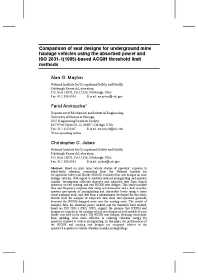Mining Publication: Comparison of Seat Designs For Underground Mine Haulage Vehicles Using the Absorbed Power and ISO 2631-1(1985)-Based ACGIH Threshold Limit Methods
Original creation date: July 2005
Based on prior mine vehicle studies of operators' exposure to whole-body vibration, NIOSH researchers evaluated four seat designs on mine haulage vehicles with regard to roadway-induced jarring/jolting and operator comfort. Investigators collected objective and subjective data from vehicle operators on two existing and two NIOSH seat designs. This study included time and frequency response data using accelerometers and a data recorder, operator perceptions of jarring/jolting and discomfort levels using a linear visual analog scale, and data from a questionnaire developed for this study. Results from the analysis of subjective data show that operators generally favored the NIOSH-designed seats over the existing seats. The results of analyses from the absorbed power method and the threshold limit method, based on ISO 2631-1, support the premise that NIOSH seat designs are superior to the existing vehicle seat designs on both models of mine shuttle cars used in the study. The NIOSH seat designs, featuring viscoelastic foam padding, were more effective in reducing vibration energy for operators exposed to vehicle jarring/jolting. In this paper, the performances of the NIOSH and existing seat designs are compared relative to the operator's exposure to vehicle vibration (mainly jarring/jolting).
Authors: AG Mayton, F Amirouche, CC Jobes
Peer Reviewed Journal Article - July 2005
NIOSHTIC2 Number: 20030404
Int J Heavy Vehicle Syst 2005 Jul; 12(3):225-238
See Also
- Computer Design and Evaluation Tool for Illuminating Underground Coal-Mining Equipment
- Evaluation of Seat Designs Relative to Transmitted Vehicle Vibration on Underground Mine Transport Vehicles
- Experiments on Personal Equipment for Low Seam Coal Miners: IV. Incorporating Coiled Cord Into Cap Lamp Battery Cords
- Inexpensive, Easy to Construct Materials-handling Devices for Underground Mines
- Laboratory Investigation of Seat Suspension Design Performance during Vibration Testing
- Physiological Responses and Subjective Discomfort of Simulated Whole-Body Vibration From a Mobile Underground Mining Machine
- Self-Reported Musculoskeletal Symptoms Among Operators of Heavy Construction Equipment
- Systematic Comparison of Different Seats on Shuttle Cars Used in Underground Coal Mines
- Task Analysis
- Whole-Body Vibration Exposure Comparison of Seat Designs for Low- and Mid-Seam Shuttle Cars in Underground Coal Mines
- Content source: National Institute for Occupational Safety and Health, Mining Program


 ShareCompartir
ShareCompartir
